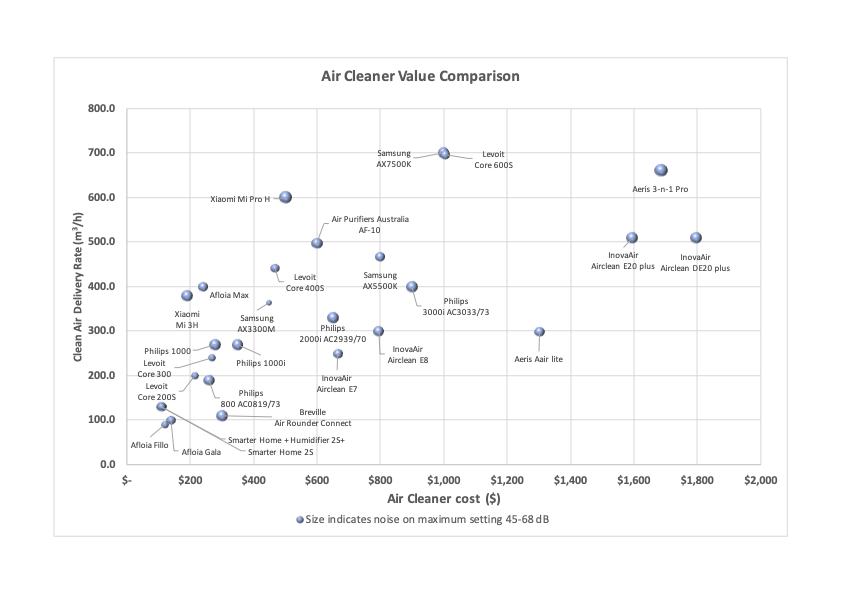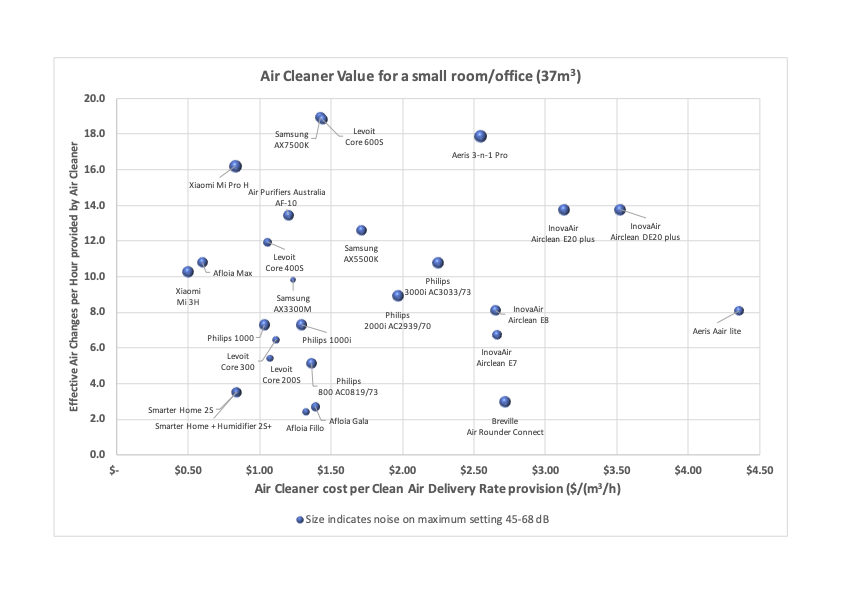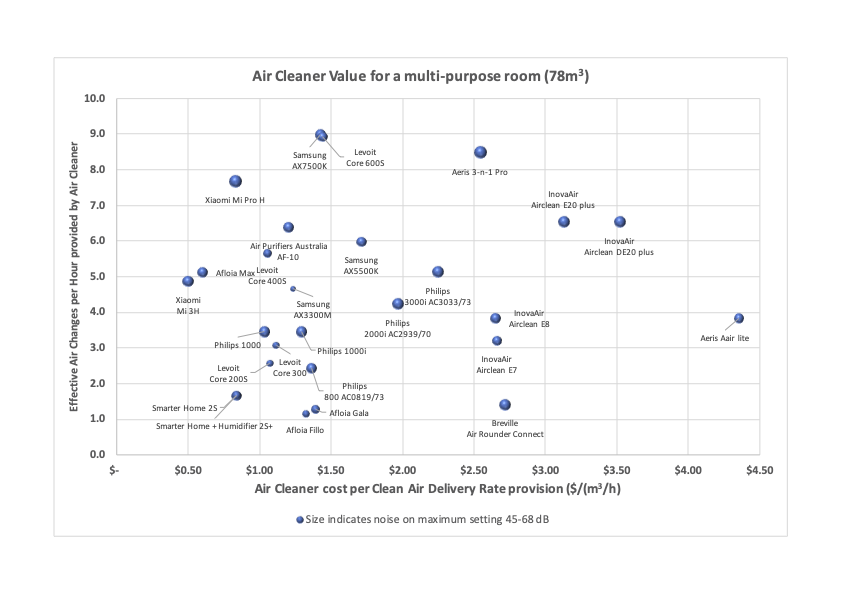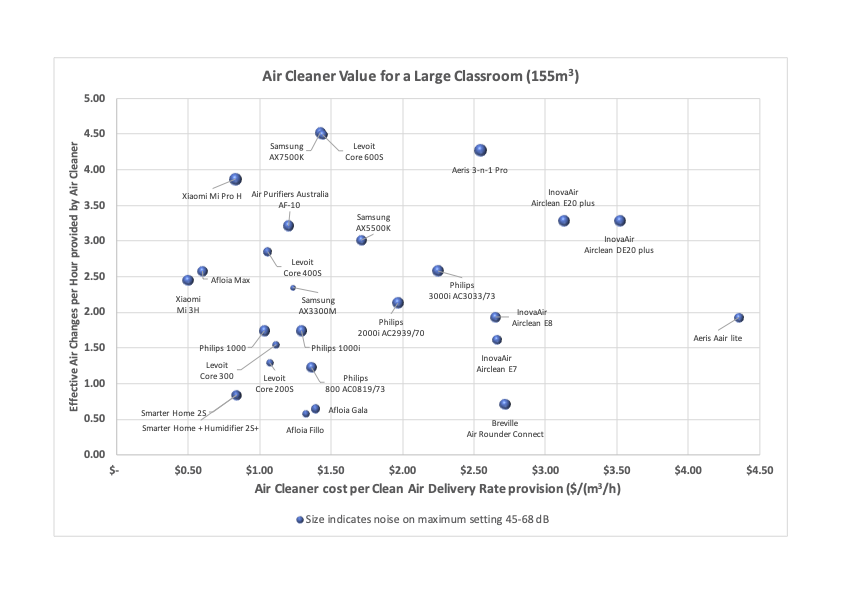Find out what will and won't help when it comes to protecting yourself and others from airborne transmission of SARS-CoV-2 with portable air cleaners.
This fact sheet explains the basics of air filtration and what to look for (and avoid) when purchasing an air cleaner. We have linked particular terms and ideas to pop-up boxes with definitions or additional information.
What do air cleaners do?
Air cleaners (also called air purifiers or scrubbers) use high efficiency particulate air (HEPA (H13 or H14)) filters to remove 99.97% of aerosolized virus particles in the air. Consisting of a fan and a layered filter, they work very effectively to clean the air of aerosols. They can provide an extra layer of protection in indoor settings where occupancy is high and there’s increased risk of airborne transmission.
How do I know if I need an air cleaner?
Air cleaners reduce virus particles in the air when ventilation is poor. Air cleaners do not remove CO2: they remove particles very effectively. A CO2 monitor showing levels greater than 800 ppm indicates that the air indoors is not being refreshed fast enough with outside air?. Improving outdoor air ventilation of our indoor spaces through opening windows/doors, creating cross ventilation, improving mechanical (HVAC) ventilation is required. Air cleaners are an extra tool in our arsenal to reduce the risk further and to get the effective air changes to where we need them to be.
For healthy indoor air, we are aiming for 6 Air Changes per Hour (ACH),? or much higher if 90%+ clearance is desired.
Unfortunately, this target is hard to achieve with our current buildings and existing ventilation systems, as well as how we currently use our indoor spaces and while maintaining heat and energy efficiencies.
You can calculate your risk of airborne transmission by downloading the Queensland University of Technology's Airborne Infection Risk Calculator or the University of Colorado's COVID-19 Aerosol Transmission Estimator.
What to consider when purchasing an air cleaner
Things to look for
If you decide an air cleaner will help reduce risk in your space, these are what you should consider when purchasing one:
- A HEPA (H13 or H14 only) air cleaner
- The Clean Air Delivery Rate needs to be sufficient for the room volume
- Maximum tolerable noise – fans are noisy, and it can sometimes make sense to have two quiet (<40dB) portable air cleaners rather than one large cleaner (>50dB)
- Cost
- Australian-made products and expected delivery times.
Things to avoid
- Directional fans without any filtration that blow air from person to person could lead to unintended transmission
- Ionisers, plasma/ozone/photocatalytic oxidation/precipitators and UV purification
- Air disinfection or air fresheners that introduce chemicals to the air to destroy biological threats such as virus, bacteria and mould (technically, these are pesticide products). Such devices distribute ozone, hydrogen peroxide or essential oils/fragrances to the air.
These are unproven/untested technologies, and in some cases dangerous technologies?, significantly degrading the air quality by producing ions, ozone and oxidation products. Ozone and ions can trigger asthma so these technologies should be avoided. Air circulation without filtration has been shown to lead to super-spreader events.
Tools to help you purchase an air cleaner
-
Australian product comparisons
Measure the cost efficiency, air quality and noise output of all the safe air cleaner products currently in the Australian market.
-
Which air cleaner is right for me?
Every room is different, and everyone has different needs when it comes to sound levels and costs. Use this dynamic tool to work out which air cleaner is right for you.
-
Frequently asked questions about air cleaners
Whether you're a technical expert, an educator or a member of the public, we answer your most pressing questions about air cleaners.
Declaration: Robyn Schofield and the University of Melbourne does not receive any funding from air cleaner manufacturers.
Indoor air does not have regulatory standards in Australia. Currently no standardised and independent testing of air cleaning devices is required or performed to protect consumers. If you found this information useful and would like to support our University of Melbourne ventilation and filtration work, please consider a donation.
© 2022. This work is licensed under a CC BY 4.0 license. Attribution – These graphs were produced by Robyn Schofield, University of Melbourne and can be used and improved upon with attribution under the creative commons license.
CO2 levels are approximately 400ppm (400 parts per million air molecules) in outside air. Humans breathe out 37,000ppm with each breath. For more information, see Exhaled CO2 as a COVID-19 Infection Risk Proxy for Different Indoor Environments and Activities by Zhe Peng and Jose L. Jimenez, and Robyn Schofield's interview with ABC News Radio and more recently on RRR (at 32 minutes).
The New Zealand Ministry of Education released a great resource for ventilation, CO2 and schools: Designing Quality Learning Spaces: Indoor Air Quality and Thermal Comfort [PDF].
ACH = Q/V where Q is the ventilation rate (m3/h) the rate of air supplied at the air inlet and V is the volume of the room.
To achieve 99% clearance, >30 effective ACH is required; in our study at the Royal Melbourne Hospital, this was achieved with two air cleaners taking 5.5 minutes to clear a single patient room.
See Indoor Air Changes and Potential Implications for SARS-CoV-2 Transmission by Joseph G. Allen, DSc, MPH; Andrew M. Ibrahim, MD, MSc for more information on how experts have come up with these targets.
The American Society of Heating, Refrigerating and Air-Conditioning Engineers (ASHRAE) has prepared a Position Document on Filtration and Air Cleaning [pdf], finding only limited data documenting the effectiveness of gas-phase air cleaning as an alternative to ventilation. Todd Crawford, et al., demonstrated the degradation of indoor air quality caused by corona technology with air cleaners in ASHRAE Journal; New York Vol. 60, Iss 12 (Dec 2018): 64–67.
The California Air Resources Board also released a list of potentially hazardous ozone generators sold as air purifiers, recommending that they not be used, and Marwa Zaatari and Marcel Harmon penned an open letter to school district facility managers and administration leadership to address the use of electronic air cleaning equipment in school facilities.
Real-Time Laboratory Measurements of VOC Emissions, Removal Rates, and Byproduct Formation from Consumer-Grade Oxidation-Based Air Cleaners, by Qing Ye et al., highlights the fact that ozone, formaldehyde and VOCs are emitted continuously from plasma, UV-C + Ti02, UV-C + anions and photoelectrochemical oxidation.
Fragranced consumer products are a major source of VOCs. These fragrance chemicals (including essential oils) are unregulated and have well documented adverse health effects for ~33% of the adult population – costing an estimated $2.7 billion to the Australian economy per year.



